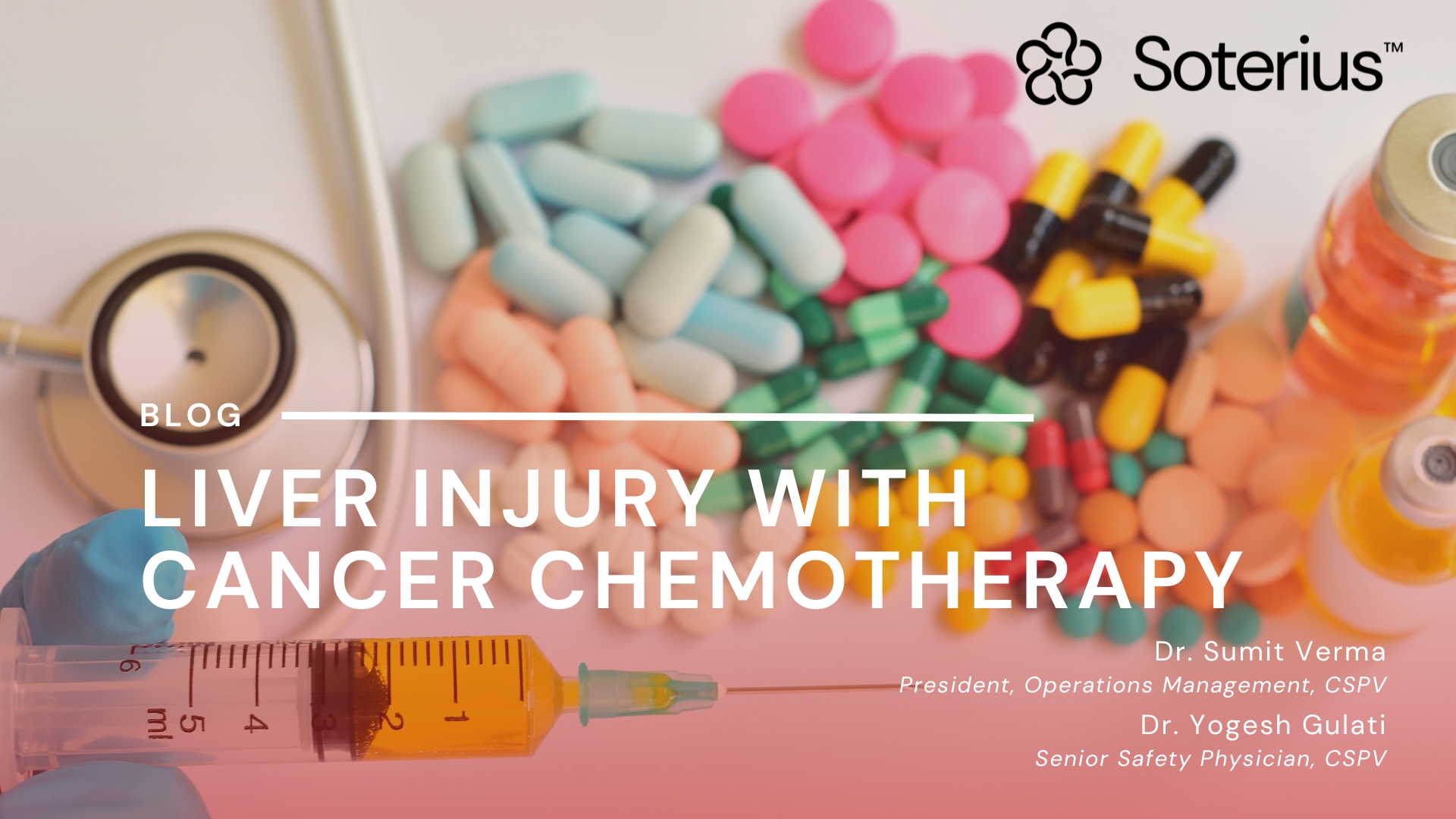
Liver Injury With Cancer Chemotherapy
Liver Injury with Cancer Chemotherapy -Importance of the Product Label in Risk Satisfaction
Cytotoxic chemotherapy is frequently associated with serum Aminotransferase elevations that are self-limited and that may subside with continued therapy. However, rare occurrences of jaundice and liver failure have been reported in association with many of these drugs. Hepatotoxicity identified during clinical development (instead of post-marketing data) is often the basis for the liver toxicity information in the labels for oncology drugs.
Generally, the evidence of potential liver injury is consistent with hepatotoxicity information in the EU Summary of Product Characteristics (SmPC) and U.S. Product Information (PI). However, there is a lack of harmonization regarding location, format, and details of information on hepatotoxicity. Although guidance on liver monitoring is generally mentioned; time to onset of Drug-induced liver injury (DILI), dose modification tables, biochemical profile, or re-challenge information are not always provided.
It is recommended to standardize the information obtained during drug development relating to liver toxicity (time of onset, pattern of injury) and to harmonize the location (sections within the label), format, and level of detail (e.g., monitoring schedule, dose modification table) in the product label.
For combination drugs, the information on liver toxicity of individual drugs (i.e., mechanism, time of onset, pattern of injury) should be used for assessing overlapping liver toxicities.
In oncology clinical trials, the NCI-CTCAE grading system is generally used for grading the severity of liver test abnormalities for suspected DILI cases, and risk management actions are recommended in the product labels based on these severity grades. Standard serum liver testing should be performed in all oncology patients prior to, during and after chemotherapy, immunotherapy or new treatments that cause liver injury.
Pre-treatment analysis for hepatic metastases with CT or MRI imaging is recommended in all oncology patients who are at increased risk for hepatic spread of tumour, prior to administration of potentially hepatotoxic chemotherapy or immunotherapy. It is important to understand the pattern of hepatotoxicity with standard chemotherapeutic drugs and the newer class of immunotherapies.
I) Standard Chemotherapeutic Drugs
Some level of hepatotoxicity as well as toxicity to other organs is generally associated with almost all anticancer drugs. With standard chemotherapeutic drugs, the hepatotoxicity is generally direct and dose-dependent; however, with many drugs, serious liver injury may also be due to idiosyncratic mechanisms. Further, hepatotoxicity may manifest in a variety of abnormal histological forms and clinicopathological phenotypes (few examples are mentioned in the Figure below).
| Type | Mechanism(s) of Hepatotoxicity (Known or Suspected) | Examples of Associated Drugs | Liver Injury Phenotype |
| Direct | Alkylation of DNA leads to damage to small blood vessels in liver
Inhibition of methionine synthesis leading to endoplasmic reticulum (ER) stress & activation of stellate cells by excess of homocysteine |
Busulfan (when given for prolonged periods), Methotrexate | Nodular regenerative hyperplasia (NRH), Steatohepatitis, Fibrosis, Cirrhosis |
| Indirect | Estrogenic effects on fat metabolism in the liver
Secondary to effects on gastrointestinal motility, gut microbiome, and bile acid levels |
Tamoxifen, Octreotide | Fatty liver, Steatohepatitis, Acute liver injury |
| Idiosyncratic | Unclear | Temozolomide, Cyclophosphamide, Melphalan, Chlorambucil, Azathioprine, Tamoxifen | Acute liver injury (mostly cholestatic) |
II) Immunotherapy
Immunotherapy includes drugs that are intended to activate or increase immunological activity against the patient’s neoplasm.
-
Immune checkpoint inhibitors (ICIs)
The patient survival in several metastatic solid organ tumours has significantly improved by immunotherapy, but these generally results in immune-related adverse events (IRAEs) including hepatotoxicity in both clinical trials and post-marketing set-up.
The use of hepatotoxic immunotherapy drugs and/or biological agents with certain other cancer drugs may result in more severe hepatotoxicity than treatment with each single drug.
The hepatic abnormalities with ICIs may range from asymptomatic increases in aminotransferases to acute hepatitis resulting in fulminant hepatic failure. These usually occur 6 to 14 weeks after initiation of treatment, although liver injury can occur after longer treatment duration and even after drug discontinuation.
-
Protein kinase inhibitors
The protein kinases whose activities are altered in cancer cells are specifically targeted by these anticancer drugs. The clinically evident liver injury with many protein kinase inhibitors is usually self-limited but may be fatal with some drugs and may be hepatocellular or cholestatic.
Features of autoimmunity have been observed in some cases of protein kinase-induced DILI, suggesting that the liver injury may be caused by an immunological autoreactive reaction. Imatinib and nilotinib have been linked to the reactivation of hepatitis B that may be due to the potentiation of hepatitis B virus replication or due to the drug’s immunosuppressive effects.
Many of the protein kinase inhibitors have been on the market only for just a few years and there is currently limited understanding as to why protein kinase inhibitors are hepatotoxic. Although there are various mechanisms that may explain the hepatotoxicity with many of these drugs, there is not enough scientific evidence in this area to make solid conclusions.
-
An overview of some of the newer cancer drugs and their currently known hepatotoxic potential is provided in the figure below:
| Drug Class | Mechanism of Action | Examples | Currently Observed Liver Injury Potential |
| Immune Checkpoint Inhibitors (ICIs) | Blocks cell surface activities of CTLA-4, PD-1, or PD-L1 to stimulate anti-tumor immune responses | CTLA-4 inhibitor: Ipilimumab, PD-1 inhibitors: Pembrolizumab, Nivolumab, PD-L1 inhibitors: Atezolizumab, Durvalumab | Immune-mediated liver injury including hepatitis (a) with some distinct histological patterns (b) |
| Antibody Drug Conjugates (ADCs) | Cytotoxic drugs covalently linked to monoclonal antibodies directed to antigens differentially overexpressed in tumour cells | Gemtuzumab ozogamicin, Trastuzumab deruxtecan, Trastuzumab emtansine | Most but not all ADCs are associated with liver toxicity, including fatal liver failure. The pattern of liver injury may differ depending on the toxophore. |
| Alpha-Specific VEGF Inhibitor and PD1/PDL-1 Combination | VEGF inhibitors may potentiate the effect of PD1/PDL-1 | Pembrolizumab plus axitinib, Avelumab plus axitinib | These combination treatments with axitinib increase the rates of higher CTCAE grades of hepatotoxicity. |
It can be difficult to characterize the risk of DILI because of low occurrence of event, limited information available, and uncertainties in pathogenesis.
In a real-world scenario, post-marketing risk management is vital to manage the risk of DILI. This is accomplished by periodic reviews and updates to the safety profile of a drug along with risk minimization measures. The product label is the basic information for healthcare professionals to refer for product safety and efficacy and which contains both preclinical and clinical information in a structured format. The product label discusses product risks in the patient population who may potentially be treated with the drug.
Risk stratification is a method for determining and predicting the possibility of a specific outcome among patients who may be exposed to certain anticancer drugs. The product label forms the basis of risk stratification by which the risks of the drug are communicated with the patients who may be treated with the drug. A risk management plan may be effective to manage the risk of DILI if the risk factors are characterized, if there are well defined patterns of liver injury, and/or there are reliable measures on which risk management and monitoring can be based upon.
References
- Drug-induced liver injury (DILI): Current status and future directions for drug development and the post-market setting. A consensus by a CIOMS Working Group. Geneva, Switzerland: Council for International Organizations of Medical Sciences (CIOMS), 2020.
- Ricart A.D. Drug-induced liver injury in Oncology. Annals of Oncology. Volume 28. Issue 8; P2013-2020, August 2017.
About Soterius
Soterius is a strong team of pharma professionals who design customized, innovative, and cost-efficient processes for clinical safety, pharmacovigilance, and medical affairs. Our deep industry knowledge and up to date insights let us combine agile, people powered intelligence in pioneering customer centric solutions. Our innovative technology solutions include engagement tools and communications platforms to create a unified and compliant medical access facility. With a strong global presence, we provide comprehensive clinical and post marketed safety services, that include aggregate report writing, signal detection and management, global literature surveillance, risk management, case processing and regulatory reporting. We use state-of-the-art technologies to solve complex safety operations problems, be it case processing, intake, site reporting for clinical trials, or literature search and management. We have one of the most accurate solutions for case intake and case processing using AI.
We support companies from the initial development stage of a drug/vaccine to the approval and ultimate marketing of the therapy, supporting ongoing operations and regulatory commitments globally.

